Battle of Grunwald. How the army of the Teutonic Order was destroyed
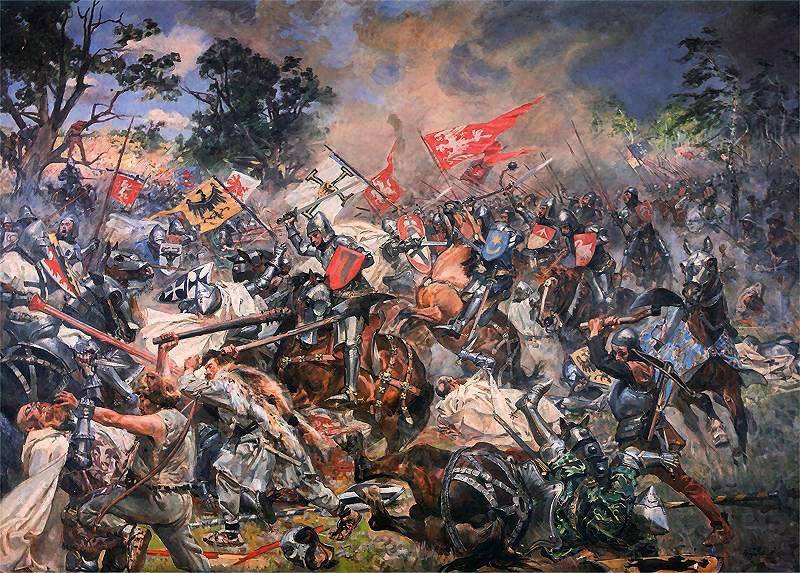
Grunwald. Hood. Wojciech Kossak
610 years ago, Polish, Lithuanian and Russian troops defeated the army of the Teutonic Order in the battle of Grunwald. The allied forces stopped the expansion of the crusaders to the east and laid the foundation for the military-economic decline of the Order.
Onslaught to the East
In the XIII century, the Teutonic Order settled on Slavic lands and began a crusade to the east. At first, the crusaders fought with the Slavic-Russian Union of Prussians-Prussians. By 1280, the Teutons, with the support of Rome and the Holy Roman Empire (at various times, it included Germany, Italy, Burgundy and the Czech Republic), conquered Prussia. Most of the Prussians were destroyed, some were enslaved, some fled to the lands of Lithuanian tribes. Earlier, many Lutich-lyutichs (Slavic people) also fled to Lithuania. As a result, the Slavs played an important role in the ethnogenesis of the Lithuanians. In general, at this time there was no big difference between the Slavs-Rus and the Balts. Moreover, the Baltic tribes preserved the cults of common gods like Perun-Perkunas, Veles and others, more than the Russians themselves. Their Christianization came later.
After the conquest of Prussia, the time of the Grand Duchy of Lithuania and Russia came. Now the information that Lithuania was then a Russian principality was almost erased. The official language was Russian, two branches of the Russian faith prevailed: paganism and Orthodoxy. The vast majority of the lands and population of the Grand Duchy were Russians. For almost a century, a fierce battle for Jeymatia (Zhmud) was in full swing. In 1382, during a feud in Lithuania (the princes Keistut and Vitovt fought with Jagiello, the crusaders supported one side or the other), the crusaders captured most of the region. However, the pagans continued to offer stubborn resistance until the Great War of 1409-1411. In response, the Teutons, receiving chivalrous reinforcements from Germany, France and the Netherlands, devastated Zhmud several times. Knights literally hunted for pagans - as for wild animals.
In 1385 the Union of Krev was concluded: the Grand Duke of Lithuania Jagiello married the Polish Queen Jadwiga and became the Polish king. Jagiello recognized Vitovt as the Grand Duke of Lithuania, and he, in turn, recognized Jagiello as the supreme overlord of the Grand Duchy. Jagiello and Vytautas were to complete the Christianization of the Grand Duchy of Lithuania and Russian according to the Western (Catholic) rite. This agreement became the basis for the subsequent Westernization and Catholicization of the Principality of Lithuania and the resistance of the Russian people, who began to see the new center of Russia in Moscow.
Great War
The Order considered this agreement to be a show. The Teutons did not give up aggression in the region. It was a matter of faith, power, and wealth (land). Even the Christian princes Jagiello and Vytautas, the crusaders considered the “repainted” pagans. Also, the Order did not want to abandon territorial expansion. The knight brothers wanted to secure Zhmud, the Polish Dobrzyń land and Gdansk. Poland sought to return part of Pomerania and Helminsky land captured by the crusaders. It was vitally important for Poland and Lithuania to halt the further advancement of the Order to the east. In addition, the Teutonic Order hindered the economic development of the two Slavic powers. The knights controlled the mouths of the three major rivers of the region: the Neman, the Vistula and the Western Dvina, which flowed through the Polish and Lithuanian territories.
Thus, it was a confrontation not for life, but for death. War was inevitable. Both sides knew this and were preparing to continue the struggle. In the spring of 1409, Zemaitiya again rebelled against the Order. Lithuania supported the Zheymats, and Poland expressed its readiness to stand on the side of the Grand Duchy. In August, Grand Master Ulrich von Jungingen declared war on the Lithuanians and Poles. The knights immediately launched an attack and captured several border fortifications. The Poles went on the counterattack and recaptured Bydgoszcz. In the fall, a truce was concluded until the summer of 1410.
The Order, Poland and Lithuania were actively preparing for the decisive battle, forming armies, looking for allies and actively blaming each other for all sins. For a big bribe, the Teutons received the support of the Hungarian king Sigismund. The Teutonic Order was also supported by the Czech king Wenceslas. Large orders of Western European knights and mercenaries (Germans, French, Swiss, British, etc.) arrived to help the Order, who hoped for great booty in the lands of "heretics" and pagans. By the beginning of 1410, the army of the Order was increased to 60 thousand people. Meanwhile, Vitovt achieved a truce with the Livonian Order and escaped a war on two fronts.
Jagiello and Vitovt agreed on a joint campaign in the lands of the Order, intending to defeat the enemy army and take the capital of the Order - Marienburg. To deceive the enemy, the Allies made small demonstrations on their borders. The knights were shown to be attacked from two directions. Therefore, the command of the order chose a defensive strategy, the crusaders were waiting for an invasion from two sides: from Poland along the Vistula to Gdansk and from Lithuania along the Neman to the Ragnit fortress. Part of the troops of the Order was located on the border in castles, and the main forces were concentrated in Sweden, from there to come forward to meet the enemy. The crusaders were going to destroy the main forces of the enemy in a decisive battle.
Polish troops gathered in Wolborz, Lithuanian-Russian - in Grodno. The exact number of warriors is unknown. The forces of the Order are estimated at 51 banners, about 27-30 thousand people, about 100 bombers. The Teutonic army also included regiments of dependent Polish feudal lords. The main force of the Order was well-trained and armed heavy cavalry. But there was also infantry: crossbowmen, archers and gunners. Poland placed 50-51 banners (including several Russians from Podillia and Galicia), Russians and Lithuanians - 40 banners, only about 40 thousand people (according to other sources, up to 60 thousand soldiers). On the side of the allies were units from the Czech Republic and Moravia, Moldova, Hungary and the Tatar horse detachment. The cavalry was also the basis of the allied army, but a significant part of it was light (especially in the Russian-Lithuanian army), the infantry mainly defended the camp.
A banner is a banner, a tactical unit in an army that roughly corresponds to a company. The banner consisted of 20–80 copies, a tactical unit that consisted of a knight, his squire, archers, swordsmen, spearmen, pages and servants. The richer the knight (feudal lord), the more and better the spear was armed. As a result, banners ranged from 100 to 500 fighters.
The death of the Teutonic army
On June 26, 1410, the Jagiello army left Velborg and a week later joined forces with Vytautas near Cherven. The Allies launched an offensive in the direction of Marienburg and on July 9 crossed the border of Prussia. The two armies met at the villages of Tannenberg and Grunwald. The army of the great master was the first to arrive there and prepare for defense. Von Jungengen decided to defend himself at the first stage of the battle: prepared traps (wolf pits), set up bombards, covered them with archers and crossbowmen. The order command was going to upset the enemy regiments, and then deliver a powerful blow with a heavy cavalry and destroy the enemy. The knights lined up in two lines at a front line of 2,5 km. In the first line on the left flank were 15 banners of the great Marshal Friedrich von Wallenrod, on the right - 20 banners under the great commander Kuno von Lichtenstein. In the second line, in reserve - 16 banners of the great master.
The Allies lined up in three lines at a front of 2 km, each with 15-16 banners. On the left flank there are 51 Polish banners (including 7 Russians and 2 Czech) under the command of the Krakow governor Zyndaram, on the right flank there are 40 Russian-Lithuanian banners and the Tatar cavalry. Smolensk regiments stood at the junction, which were strengthened by other Russian banners during the battle. At dawn on July 15, 1410, troops were built. The Teutonic Knights wanted the enemy to act first, which led to the breakdown of his ranks and facilitated the breakthrough of the Polish-Lithuanian line. Therefore, until noon, the troops stood and suffered from the heat. Jagiello, apparently sensing danger, also did not want to be the first to start the battle. To provoke the enemy, the Crusaders sent heralds with two drawn swords to Jagaille and Vitovt (the so-called Grunwald swords). The master conveyed that these swords "should help the Polish and Lithuanian monarchs in the battle." It was a challenge and an insult.
Vytautas attacked the light cavalry, including the Tatars Jalal ad-Din (the son of Tokhtamysh, he hoped with the help of Lithuania to seize power in the Horde). The bombers fired several shots, but the efficiency was low, and it started to rain. Traps and arrows did not stop the light cavalry. The light riders in the frontal attack could not do anything with the heavy knights of Wallenrod. Then Wallenrod's cavalry went on the counterattack, and Vitovt's light cavalry rolled back. It is believed that this was a typical tactic for the Eastern cavalry to lure the enemy into a trap. Part of the knights, believing that this was a victory, was carried away by the chase and rushed to pursue the Russian-Lithuanian cavalry. The crusaders reached the camp, where they got bogged down in the fight against infantry (militia warriors). When these crusaders, frozen in battle with the militias, abandoning their prey, returned to the battlefield, the battle was already lost. The other part of Wallenrod's cavalry joined the battle with the remaining troops of Vytautas. The stubborn felling began. Russian banners, including Smolensk regiments, took a hit and suffered heavy losses. The advanced gonfalons fell almost completely, but they were replaced by the rear. They fulfilled their task: the heavy knightly cavalry got bogged down, lost mobility and striking power.
Meanwhile, von Liechtenstein's banners hit the Polish army. They were joined by several Wallenrod banners. The blow was scary. The advanced Polish gonfalons suffered huge losses. The knights captured the great Krakow banner. The Teutons took this as a victory. But the Poles violently rush into a counterattack, the second-line gonfalons enter the battle. The battle was extremely stubborn, one of the crusaders broke through to Jagail himself, but he was cut down. At 5 o'clock having decided that the victory was already near, the great master led the reserve gonfalons into battle. Obviously, von Jungingen was late with the introduction of fresh forces into the battle. In response, the Poles threw the third line into the battle, and the light Tatar, Lithuanian and Russian cavalry returning to the battlefield began to surround the enemy’s heavy gonfalons bogged down in a heavy wheelhouse. On the Grunwald hills, the crusaders were driven into two "cauldrons". They quickly grew into walls of the remains of all regiments, light cavalry, Lithuanian and Polish infantry. The Order Army drowned in blood. The Wallenrod knights tried to break through, but everywhere they were beaten off. The encirclement ring pulled together. As a result, the main forces of the order of the cavalry were destroyed and captured. The last battle the rest of the cavalry and the Prussian infantry tried to give in the camp near the village of Grunwald, but then they were quickly swept away. A small part of the order army fled.
It was a complete rout. Almost the entire command of the Order was lost, including the great master Jungingen and the great marshal Wallenrod, from 200 to 400 order brothers (there were 400-450 of them in total), many foreign knights, mercenaries. Many were captured. The losses of the Order are estimated at 22 thousand people (including 8 thousand killed and about 14 thousand prisoners). The losses of the allied army were also heavy, up to 12–13 thousand killed and wounded. But in general, the army retained the combat core and combat readiness, unlike the enemy.
The allied command made a mistake: for three days the troops "stood on the bones." Light banners did not send to take almost defenseless Marienburg-Malbork. When the army moved, the king was in no hurry, he was already sharing the skin of the Teutonic bear, distributing it to the city and fortress. At this time, the decisive Svetsen commander Heinrich von Plauen (he did not have time to take part in the battle) was the first to get to Malbork and organized his defense. The Allies could not take an impregnable fortress; they had to leave. In the northeast the Livonians stirred, in the west the Germans gathered new forces.
Thus, it was not possible to crush the Teutonic Order on the move. In 1411, peace was made. The Teutons returned the disputed territories to Poland and Lithuania, paid indemnity and ransom for prisoners. The expansion of the Teutonic Order to the east was stopped. Grunwald was the beginning of the military-political decline of the Order. His authority, military power and wealth were undermined. Soon the leading positions in the region were taken by the union of Poland and Lithuania.
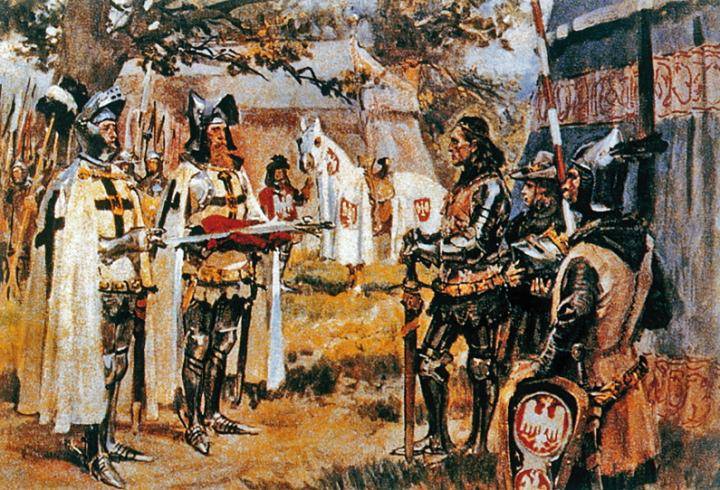
"Two swords." Wojciech Kossak
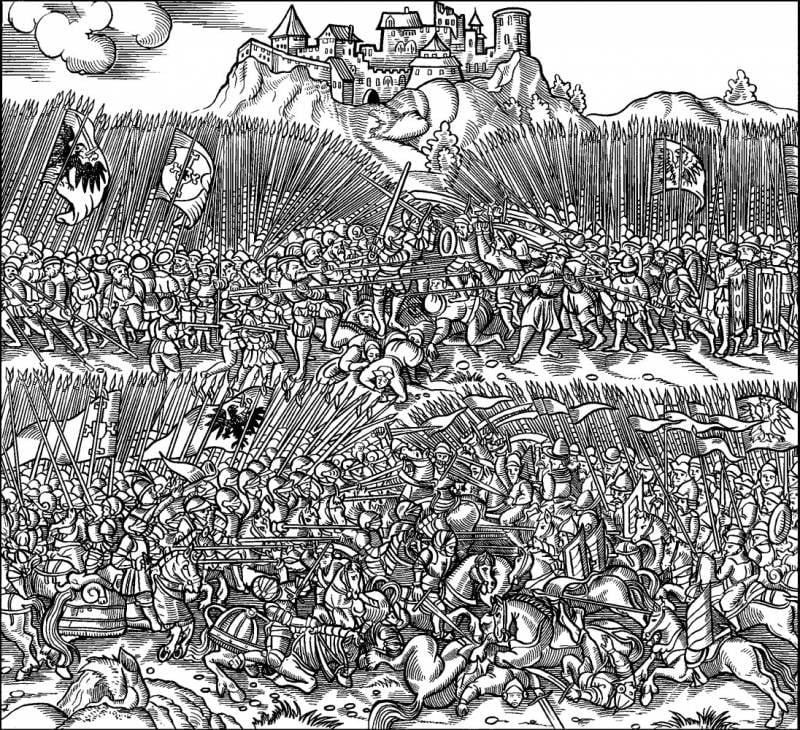
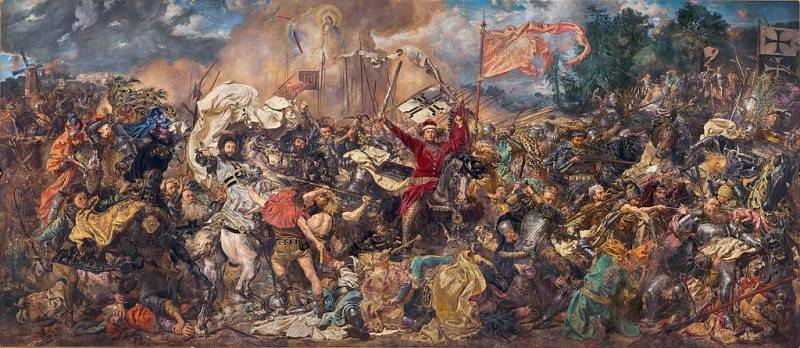
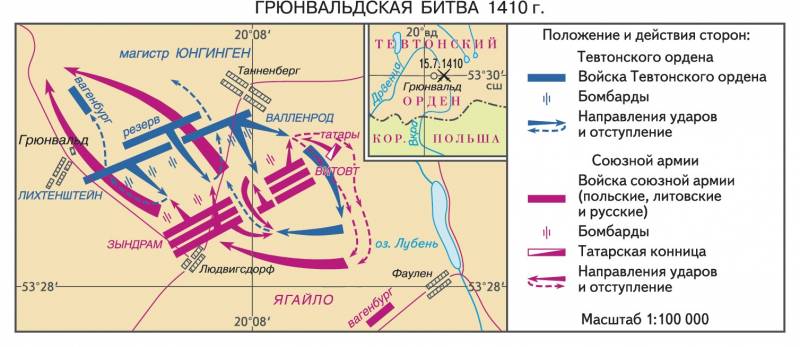
Information